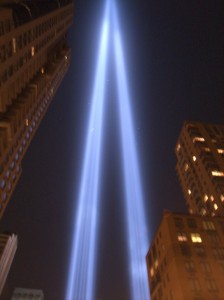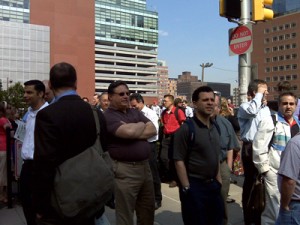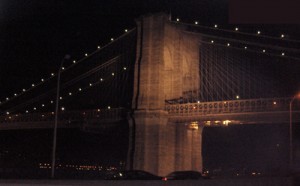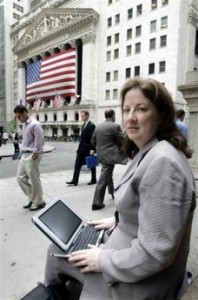The weather today was similar to this date nine years ago: sunny and mild, with temperatures in the 70’s. That contributed to the disorientation I felt back then: there was a complete disconnect between the comfort and ease of a beautiful fall day and the smoke coming from the World Trade Center site, reaching high into the sky, blowing smoke clouds that completely covered the high-rise apartment buildings to the south. I remember the eerie calm as I left my apartment building with my neighbor and his dog when we walked over to the Hudson River where police boats were waiting to evacuate us to New Jersey. I just remember the feeling of an other-worldliness, like this couldn’t be happening. But it was very, very real. In the days that followed, I had a dual screen on Lower Manhattan. I was staying in an apartment on the Jersey City waterfront, directly facing the World Trade Center site. I could look out the window and see the view simultaneously on the television screen. When the navy’s hospital ship, the U.S.N.S. Comfort sailed up the Hudson River, I saw it from the window and on the television screen and realized the window view was better. Sadly, most of the beds on the ship remained unused as few survivors were found. I briefly watched the memorial ceremony on television this morning, as family members read the names of their loved ones. But I became tearful and turned the television off. Right now, there is a party boat blasting music on the Hudson as passengers drink and dance. I find the intrusion incredibly annoying. I will go to sleep early and tomorrow will be a new day. My friends in New Orleans, by the way, tell me that they become very cranky and irritable on August 29, their anniversary date. Just being aware that these emotional reactions are normal makes them more manageable.
Posts Tagged ‘9-11’
Day of Remembrance
Saturday, September 11th, 2010At Least They Told Us This Time
Sunday, May 17th, 2009The largest disaster drill since September 11, 2001 at the World Trade Center site took place this morning. New York City officials staged a mock explosion on a PATH commuter rail train in the tunnel linking Lower Manhattan, at the World Trade Center terminus, to northern New Jersey. Hundreds of police officers, firefighters and Port Authority of New York and New Jersey officials participated, along with 150 volunteers who pretended to be victims of the explosion. City officials advised downtown residents in advance of this drill. PATH rail service was suspended Sunday morning until the drill was completed.
Not Again!
Monday, April 27th, 2009In Prepare for the Worst, Plan for the Best: Disaster Preparedness and Recovery for Small Businesses (John Wiley & Sons Inc., second edition, 2008), I wrote (page 190) that “the residents {of Lower Manhattan} who heard the planes crash into the towers were especially sensitive to loud noises. I remember being woken up at 3:30 a.m. one morning by a pair of F-16 planes overhead. As it turns out, the planes were not supposed to fly that route at that hour. The pilots presumably did not appreciate that the residents of Lower Manhattan were probably sleep-deprived and hyper-alert to such sounds. Having spent some time with small businesses on the Gulf Coast, I can tell you that they are going through exactly the same process.” Today, the White House organized a photo opportunity that consisted of a military aircraft chasing a civilian aircraft over the airspace of Lower Manhattan, directly in the vicinity of Ground Zero. You can imagine the reaction that was provoked by that abuse. The White House claims that New York City authorities were given advance notice of this planned exercise, presumably implying that local authorities were responsible for the anxiety that ensued. My colleague photographed the planes with his cell phone, which is the first photograph on this blog entry. The second photograph shows a group of Dow Jones employees, nearly all of whom worked in the World Financial Center on 9-11, outside their office building when a mandatory evacuation had been ordered.
The context of the quote from my book concerns the emotional reactions to disasters, sometimes years after the original event, which is something you have to anticipate. One of my colleagues said it best in an e-mail he sent to our group, so I will quote him directly “The fact that the White House could not be bothered to let the New York authorities know that there would be A FIGHTER JET CHASING A PLANE! AROUND LOWER MANHATTAN really makes me wonder who is keeping Gotham safe when something actually happens. I am sufficiently enraged that I will be communicating in ALL CAPS for the rest of the day.” So I think you get the point about emotions. Actually, all Americans should be angry about this, not just those of us in Lower Manhattan who were subject to more abuse. The White House has some explaining to do as to why taxpayer monies were spent on this “photo op”. Don’t we have an unemployment rate approaching 10%? Haven’t our as yet unborn grandchildren been sold as indentured servants to our foreign creditors? It is not like we have money to burn.
The Tragedy That Never Ends
Sunday, April 19th, 2009For the small businesses that are based in Lower Manhattan in the vicinity of the World Trade Center site, and for the families that also live there, there is no end in sight. The ongoing reconstruction of the site, the round-the-clock noise and disruptions and concerns about environmental hazards (coupled with an extraordinary process for the demolition of 130 Liberty Street, the office building opposite the WTC) should have ended years ago. The endless and inexplicable delays prolong emotional trauma that should be healed and needlessly disrupt lives. It is an abuse of the residents and small businesses and an abuse of the American taxpayers who are underwriting this farce. Today there was another unwelcome but not, given the history, unexpected, development.
The Associated Press cites anonymous sources within the Port Authority of New York and New Jersey, the government agency which owns the World Trade Center site, that construction of two of the three towers planned for the site may be delayed for more decades, possibly until the year 2030. The delay is attributed, in part, to conditions in the real estate market. Of course, these market conditions would not be pertinent had the reconstruction proceeded in a more efficient manner: the site would should have been redeveloped years before the collapse of the credit markets at the end of 2008.
The other sad irony, that was not cited in the AP report, is that the various subsidies offered to real estate developers, such as Liberty Bonds on a tax-advantaged basis, probably undermined market forces in a way from which Lower Manhattan is unlikely to recover. The various corporate welfare programs incented developers to flip from commercial to residential properties. I am not a big believer in “if you build it, they will come”. Rather, I would see an entrepreneurial opportunity in response to market demand. If you think that there is a demand to live in the financial district, go there and try to buy a newspaper on the weekend or find a decent restaurant that is open late at night. In any event, the developers responded in a rational way by taking the incentives. Many small businesses, such as my own, that were successful were displaced to make way for these grand scheme projects, that now sit vacant.
Large downtown employers in the financial district (such as Lehman Brothers and Merrill Lynch) no longer exist and others (AIG) are in trouble. With fewer jobs available in the financial district, and no other reason to live there unless you are an investment banker who works 100 hours a week in that neighborhood, there is little demand to buy apartments. There is such too much uncertainty about employment in that community and mortgage financing is harder to access. I made the decision to move out of our Wall Street office with very little enthusiasm. I miss that community. But now I am glad I did. The photograph, by the way, is one I took of a more enduring symbol of New York. I snapped a picture of the Brooklyn Bridge illuminated at night from my seat in a taxi cab as we were driving down the FDR. I find it to be a more optimistic picture than that of Wall Street now, with its chain retailers, it has lost its character.
Clouds on the Horizon
Wednesday, March 11th, 2009Crain’s New York Business reports that Lower Manhattan is “on the edge”, citing the following grim statistics:
- 48,000 fewer workers downtown than before Sept. 11
- 2.7 million fewer tourists downtown than before Sept. 11
- 13% of downtown real estate is occupied by AIG, Merrill Lynch and Goldman Sachs
- 12 million square feet expected to come on the market, excluding financial services consolidation
- 57,000 residents in lower Manhattan
- 1/3 of all downtown jobs are tied to financial services, insurance and real estate
The Lower Manhattan community has not fully recovered from the losses caused by the events of September 11 and now faces a much greater threat from the collapse of the financial sector, the leading employer in New York City. Local restaurants report that business is down as much as 40% as compared with this time last year and other small businesses that serve the financial sector, such as car services, law firms, accounting firms, print shops, etc., report comparable declines. Given the lack of diversification of the economy, the mood in the community is grim. The consequences to our local economy here in New York are not likely appreciated elsewhere across the United States, given the entirely appropriate focus on the consequences of the credit crisis for all of us. But for many of us here, the financial crisis is a small business disaster. What has not yet been reported, and I hope will attract the attention of journalists, is that many of the same institutions currently receiving bailouts in the form of TARP funds also received federal government aid in the aftermath of 9-11 – aid which was championed for the benefit of firefighters and emergency rescue workers with urgent medical needs, small businesses and other less powerful constituencies.
Welcome To My Blog, Pertinent Perils!
Friday, September 5th, 2008Welcome to my new blog! This blog is the product of entrepreneurial inspiration! I am an entrepreneur and, on 9-11-01, my small business office was located in “Zone 1” of the World Trade Center. On that fateful morning, I was in the WTC when the planes struck the first tower. I safely exited the building and placed a cell phone call to my office and then to a friend who was on his way in from Brooklyn to meet me. I tried to reach him to advise him to turn around and go home, and, as it was not safe to be about, I did the same.
My home was located in the residential community in the shadow of the World Trade Center. I was in my apartment when the towers fell, in part, on my building. Then, together with my neighbor and his dog, I was evacuated by police boat across the Hudson River to New Jersey where I remained, homeless, for several months. I was allowed to return home once during this time to retrieve some clothing and other personal belongings. Mine was the only residential neighborhood evacuated, closed and placed under the control of the National Guard. Civil authorities allowed my office building to re-open on September 18, 2001, one week to the day later. This was largely because of the symbolic importance attached to re-opening Wall Street and the New York Stock Exchange. Had we been located a block in either direction, our re-opening would have been further delayed. Even so, we were without essential services for some time, such as electricity, land line telephone, gas, water, mail delivery and pedestrian access. I had to file insurance claims, deal with disaster relief agencies and programs and put into effect an environmental remediation of my office to remove the soot and ash.
I soon realized my experience was very unusual. Few small businesses in Lower Manhattan were prepared to work through such a major disruption. Ours was a statistical outlier in terms of preparedness. This is an accident of two unusual professional backgrounds. Prior to starting the business, I lived in Zurich, Switzerland where I was a senior executive of the world’s largest reinsurance company. Reinsurance companies are the ultimate providers of risk capital and so invest considerable effort in advising their corporate clients in respect of disaster preparedness, business continuity and risk management strategies. This background was of enormous help to me in responding to the consequences of what happened on 9-11.
I was doubly fortunate to have Stefan Dietrich as my business IT guru. Stefan has a doctorate in engineering and computer science and completed his post-doctoral training in computer science at Cornell University. He had contributed to the disaster recovery operations (and future business continuity planning) of Deutsche Bank in London following the bomb attack on Bishopsgate. He had me all set up with appropriate data backup, application access, an appropriate communications plan – you name it!
Few small businesses had the experience that would lead to our insight and so, after providing pro bono help to my fellow Lower Manhattan small business owners to aid their recovery efforts, we decided to write a book to share our expertise more widely and on a proactive basis. Not long after 9-11, I wrote a proposal for a book on the topic of small business disaster preparedness and recovery and one week later, that proposal was accepted. In 2002, John Wiley & Sons Inc. published Contingency Planning and Disaster Recovery: a Small Business Guide.
With weather-related and other disasters in the news, our topic continues to be timely and this summer Wiley published the second edition of our book, with 40% new material, under the title Prepare for the Worst, Plan for the Best: Disaster Preparedness and Recovery for Small Businesses. There has been particularly strong interest in the small business community for information about insurance for disaster exposures; hence, the title of my blog is “Pertinent Perils” which is reinsurance-speak for “relevant risks”.
I hope that with this blog and website we can build a community among small business owners to share best practices for disaster preparedness and recovery. With the events of 9-11, Hurricane Katrina and other major disasters, it seemed that no national learning was taking place. I am reminded of the Drew Barrymore movie 50 First Dates in which the leading lady suffers acute deficits in short-term memory such that every date she has with Adam Sandler requires that they start their relationship all over again. It is an amusing plot for an in-flight movie, but not very funny in real life. Learning the same lessons over and over again is unnecessarily costly, both in human and financial terms.
One of the challenges of entrepreneurship, which is also the one that I find the most rewarding, is that we have to become a Jill-of-all-trades. In the large corporate environment, roles and responsibilities are better defined in functional departments. When I worked in the reinsurance industry, for example, I never had to think about building a website or doing a p.r. campaign with the news media. Now I do and I see it as an opportunity to connect with others and to learn from them.
And I hope we will learn about the best as well as the worst of disaster practices. The new title of the second edition was intended to capture the lesson that disaster planning not only protects your small business against the downside, but it offers immediate, tangible benefits to your business even if disaster never strikes. I invite you to contribute to this blog and share what you can with the small business community.





